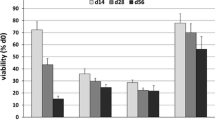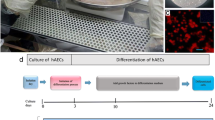Abstract
Bone morphogenetic proteins (BMPs) play important roles at multiple stages of chondrogenesis. This study was undertaken to investigate the potential role of bone morphogenetic protein-7 (BMP-7) in the differentiation of chondrocytes using tissue engineering techniques. The impact of BMP-7 on human amniotic epithelial cells (hAECs) was tested. The hAECs were treated either with recombinant human BMP-7 cDNA or with transforming growth factor beta 1 (TGF-β1) as a positive control for three weeks in vitro. Cartilaginous differentiation and proliferation were assayed by quantitative RT-PCR, histology, and in situ hybridization. Our results were such that hAECs treated with either BMP-7 or TGF-β1 expressed cartilage markers (aggrecan, Sox9, CEP-68, and type II and X collagens) within three weeks. Compared with a control vector, BMP-7 induced a decrease in type I collagen expression, while the transcription of the cartilage-specific type II collagen remained stable. In induction experiments, BMP-7 transgenic hAECs exhibited the largest amount of matrix synthesis. In conclusion, these data indicate that BMP-7 plays an important role in inducing the production of cartilage by hAECs in vitro. Cartilage differentiation and matrix maturation can be promoted by BMPs in a cartilage engineering paradigm. These properties make BMPs promising tools in the engineering of cartilaginous joint bio-prostheses and as candidate biological agents or genes for cartilage stabilisation.





Similar content being viewed by others
References
Ilancheran S, Michalska A, Peh G, Wallace EM, Pera M, Manuelpillai U (2007) Stem cells derived from human fetal membranes display multilineage differentiation potential. Biol Reprod 77:577–588
In't Anker PS, Scherjon SA, Kleijburg-van der Keur C, de Groot-Swings GM, Claas FH, Fibbe WE, Kanhai HH (2004) Isolation of mesenchymal stem cells of fetal or maternal origin from human placenta. Stem Cells 22:1338–1345
Liu T, Wu J, Huang Q, Hou Y, Jiang Z, Zang S, Guo L (2008) Human amniotic epithelial cells ameliorate behavioral dysfunction and reduce infarct size in the rat middle cerebral artery occlusion model. Shock 29:603–611
Pecina M, Vukicevic S (2007) Biological aspects of bone, cartilage and tendon regeneration. Int Orthop 31:719–720
Chubinskaya S, Hurtig M, Rueger DC (2007) Op-1/bmp-7 in cartilage repair. Int Orthop 31:773–781
Minina E, Kreschel C, Naski MC, Ornitz DM, Vortkamp A (2002) Interaction of fgf, ihh/pthlh, and bmp signaling integrates chondrocyte proliferation and hypertrophic differentiation. Dev Cell 3:439–449
Pecina M, Jelic M, Martinovic S, Haspl M, Vukicevic S (2002) Articular cartilage repair: the role of bone morphogenetic proteins. Int Orthop 26:131–136
Jelic M, Pecina M, Haspl M, Kos J, Taylor K, Maticic D, McCartney J, Yin S, Rueger D, Vukicevic S (2001) Regeneration of articular cartilage chondral defects by osteogenic protein-1 (bone morphogenetic protein-7) in sheep. Growth Factors 19:101–113
Sailor LZ, Hewick RM, Morris EA (1996) Recombinant human bone morphogenetic protein-2 maintains the articular chondrocyte phenotype in long-term culture. J Orthop Res 14:937–945
Bondeson J, Foxwell B, Brennan F, Feldmann M (1999) Defining therapeutic targets by using adenovirus: blocking nf-kappab inhibits both inflammatory and destructive mechanisms in rheumatoid synovium but spares anti-inflammatory mediators. Proc Natl Acad Sci USA 96:5668–5673
Hunziker EB, Rosenberg LC (1996) Repair of partial-thickness defects in articular cartilage: cell recruitment from the synovial membrane. J Bone Joint Surg Am 78:721–733
Poleni PE, Bianchi A, Etienne S, Koufany M, Sebillaud S, Netter P, Terlain B, Jouzeau JY (2007) Agonists of peroxisome proliferators-activated receptors (ppar) alpha, beta/delta or gamma reduce transforming growth factor (tgf)-beta-induced proteoglycans' production in chondrocytes. Osteoarthritis Cartilage 15:493–505
Perides G, Safran RM, Downing LA, Charness ME (1994) Regulation of neural cell adhesion molecule and l1 by the transforming growth factor-beta superfamily. Selective effects of the bone morphogenetic proteins. J Biol Chem 269:765–770
Nakamura Y, Wang X, Xu C, Asakura A, Yoshiyama M, From AH, Zhang J (2007) Xenotransplantation of long-term-cultured swine bone marrow-derived mesenchymal stem cells. Stem Cells 25:612–620
Karahuseyinoglu S, Cinar O, Kilic E, Kara F, Akay GG, Demiralp DO, Tukun A, Uckan D, Can A (2007) Biology of stem cells in human umbilical cord stroma: in situ and in vitro surveys. Stem Cells 25:319–331
Sudo K, Kanno M, Miharada K, Ogawa S, Hiroyama T, Saijo K, Nakamura Y (2007) Mesenchymal progenitors able to differentiate into osteogenic, chondrogenic, and/or adipogenic cells in vitro are present in most primary fibroblast-like cell populations. Stem Cells 25:1610–1617
Narukawa M, Suzuki N, Takayama T, Shoji T, Otsuka K, Ito K (2007) Enamel matrix derivative stimulates chondrogenic differentiation of atdc5 cells. J Periodontal Res 42:131–137
Hata K, Nishimura R, Muramatsu S, Matsuda A, Matsubara T, Amano K, Ikeda F, Harley VR, Yoneda T (2008) Paraspeckle protein p54nrb links sox9-mediated transcription with rna processing during chondrogenesis in mice. J Clin Invest 118:3098–3108
Pizette S, Niswander L (2000) Bmps are required at two steps of limb chondrogenesis: formation of prechondrogenic condensations and their differentiation into chondrocytes. Dev Biol 219:237–249
Kameda T, Koike C, Saitoh K, Kuroiwa A, Iba H (2000) Analysis of cartilage maturation using micromass cultures of primary chondrocytes. Dev Growth Differ 42:229–236
Haaijman A, Burger EH, Goei SW, Nelles L, ten Dijke P, Huylebroeck D, Bronckers AL (2000) Correlation between alk-6 (bmpr-ib) distribution and responsiveness to osteogenic protein-1 (bmp-7) in embryonic mouse bone rudiments. Growth Factors 17:177–192
Chao PH, Grayson W, Vunjak-Novakovic G (2007) Engineering cartilage and bone using human mesenchymal stem cells. J Orthop Sci 12:398–404
Karlsson C, Brantsing C, Svensson T, Brisby H, Asp J, Tallheden T, Lindahl A (2007) Differentiation of human mesenchymal stem cells and articular chondrocytes: analysis of chondrogenic potential and expression pattern of differentiation-related transcription factors. J Orthop Res 25:152–163
Eyrich D, Wiese H, Maier G, Skodacek D, Appel B, Sarhan H, Tessmar J, Staudenmaier R, Wenzel MM, Goepferich A, Blunk T (2007) In vitro and in vivo cartilage engineering using a combination of chondrocyte-seeded long-term stable fibrin gels and polycaprolactone-based polyurethane scaffolds. Tissue Eng 13:2207–2218
Hwang NS, Varghese S, Puleo C, Zhang Z, Elisseeff J (2007) Morphogenetic signals from chondrocytes promote chondrogenic and osteogenic differentiation of mesenchymal stem cells. J Cell Physiol 212:281–284
Acknowledgement
The authors wish to thank Michael Gross and Lian Fu Deng for their excellent technical assistance.
Competing interests
The authors declare that they have no competing interests.
Author information
Authors and Affiliations
Corresponding author
Rights and permissions
About this article
Cite this article
Zhou, J., Yu, G., Cao, C. et al. Bone morphogenetic protein-7 promotes chondrogenesis in human amniotic epithelial cells. International Orthopaedics (SICOT) 35, 941–948 (2011). https://doi.org/10.1007/s00264-010-1116-3
Received:
Revised:
Accepted:
Published:
Issue Date:
DOI: https://doi.org/10.1007/s00264-010-1116-3




